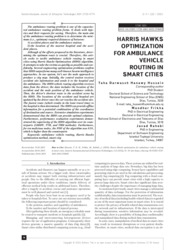HARRIS HAWKS OPTIMIZATION FOR AMBULANCE VEHICLE ROUTING IN SMART CITIES
-
Yazar
Cevat Rahebi
-
Tür
Makale
- Yayın Yılı 2023
- Veritabanları Scopus
- DOI 10.15587/1729-4061.2023.278002
-
Yayıncı
Technology Center
- Dergi Eastern-European Journal of Enterprise Technologies 2, ( 3-122 ), pp.74 - 81
- Tek Biçim Adres https://hdl.handle.net/20.500.14081/2010
-
Konu Başlıkları
Ambulance vehicle routing
Harris Hawks optimization method
Smart city
The ambulance routing problem is one of the capacitated ambulance routing problem forms. It deals with injuries and their requests for saving. Therefore, the main aim of the ambulance routing problem is to determine the minimum (i.e., optimum) required distances of between: 1) accident places and the ambulance station; 2) the location of the nearest hospital and the accident places. Although of the efforts proposed in the literature, determining the optimum route is crucial. Therefore, this article seeks to tackle ambulance vehicle routing in smart cities using Harris Hawks Optimization (HHO) algorithm. It attempts to take the victims as quickly as possible and confidently. Several engineering optimization problems confirm that HHO outperforms many well-known Swarm intelligence approaches. In our system, let’s use the node approach to produce a city map. Initially, the control station receives accident site information and sends it to the hospital and the ambulance. The HHO vehicle routing algorithm receives data from the driver; the data includes the location of the accident and the node position of the ambulance vehicle. Then, the driver’s shortest route to the accident scene by the HHO. The locations of the accident and hospital are updated by the driver once the car reaches the accident site. The fastest route (which results in the least travel time) to the hospital is then determined. The HHO can provide offline information for a potential combination of the coordinates of destination and source. Extensive simulation experiments demonstrated that the HHO can provide optimal solutions. Furthermore, performance evaluation experiments demonstrated the superiority of the HHO algorithm over its counterparts (SAODV, TVR, and TBM methods). Furthermore, for ten malicious nodes, the PDF of the algorithm was 0.91, which is higher than the counterparts © 2023, Authors. This is an open access article under the Creative Commons CC BY license
-
Koleksiyonlar
Fakülteler
Mühendislik Fakültesi


 Tam Metin
Tam Metin

